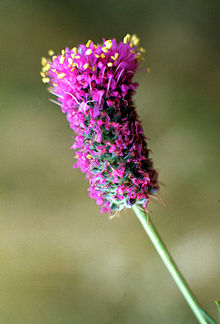- Dalea purpurea
-
Dalea purpurea 
Conservation status Scientific classification Kingdom: Plantae Division: Magnoliophyta Class: Magnoliopsida Order: Fabales Family: Fabaceae Genus: Dalea Species: D. purpurea Binomial name Dalea purpurea
Vent.Synonyms[1] - Dalea violacea (Michx.) Willd.
- Kuhnistera violacea (Vent.) Steud.
- Petalostemon violaceum Michx.
- P. pubescens (A.Gray) A.Nelson
- P. purpureum (Vent.) Rydb.
- P. standleyanus Rydb.
- Psoralea purpurea (Vent.) MacMill.
Dalea purpurea is a species of flowering plant in the legume family known by the common name purple prairie clover. It is native to central North America, where it occurs from central Canada to the southeastern and southwestern United States, except for the east and west coasts.[2][3][4] It is a common and widespread plant within its range, especially on the Great Plains.[5]
This plant is a perennial herb growing 20 to 90 centimetres (7.9 to 35 inches) tall. The mature plant has a large taproot which may grow two meters deep. The stem is woody with several branches. The leaves are a few centimeters long and are divided into 3 to 7 narrow leaflets. The inflorescence atop each stem branch is a spike up to 7 cm (2.8 in) long containing many purple flowers. The fruit is a legume pod containing 1 or 2 seeds.[5]
This plant is a common member of the flora on the plains of central North America, occurring in a variety of habitat types, including several types of grassland. It occurs in glades, riverbanks and floodplains, oak woodlands, pinyon-juniper woodlands, shrubsteppe, many types of forests, and the Sand Hills of Nebraska. It occurs in a variety of prairie ecosystems. On tallgrass prairie it is associated with plants such as little bluestem (Schizachyrium scoparium), big bluestem (Andropogon gerardii), prairie Junegrass (Koeleria macrantha), prairie dropseed (Sporobolus heterolepis), lead plant (Amorpha canescens), and silky aster (Aster sericeus). On midgrass prairie it grows alongside several grasses such as silver bluestem (Bothriochloa saccharoides), purple threeawn (Aristida purpurea), sideoats grama (Bouteloua curtipendula), and sand dropseed (Sporobolus cryptandrus). On shortgrass prairie it is associated with grasses such as blue grama (Bouteloua gracilis), hairy grama (B. hirsuta), and buffalo grass (Buchloe dactyloides). This species may be considered an indicator of pristine prairie.[5]
This species is used for revegetation efforts on reclaimed land, such as land that has been strip mined. It is good for preventing erosion and for fixing nitrogen in soil. Though it is often found in mid- to late-successional stages of ecological succession, it may also be a pioneer species, taking hold in bare and disturbed habitat, such as roadsides.[5]
This plant is adapted to a habitat with periodic wildfires. In some areas, it depends on fire to clear encroaching woody vegetation, as it cannot tolerate shade.[5]
Purple prairie clover provides food for a number of animals, such as pronghorn. It also grows in cultivated fields and becomes included in hay for livestock. It is nutritious and is "considered one of the most important legumes in native grasslands on the Great Plains." It also had a number of uses for Native Americans. The leaves are edible and good for making tea and medicines, and the roots are palatable when chewed. The stems were used as brooms by the Pawnee people.[5]
References
- ^ "Dalea purpurea Vent.". The Plant List. http://www.theplantlist.org/tpl/record/ild-15442.
- ^ Dalea purpurea. Germplasm Resources Information Network. Retrieved 11-14-2011.
- ^ Dalea purpurea. USDA Plants Profile. Retrieved 11-14-2011.
- ^ Dalea purpurea. The Nature Conservancy. Retrieved 11-14-2011.
- ^ a b c d e f League, Kevin R. 2004. Dalea purpurea. In: Fire Effects Information System, [Online]. U.S. Department of Agriculture, Forest Service, Rocky Mountain Research Station, Fire Sciences Laboratory. Retrieved 11-14-2011.
Categories:- NatureServe Secure species
- Dalea
Wikimedia Foundation. 2010.

